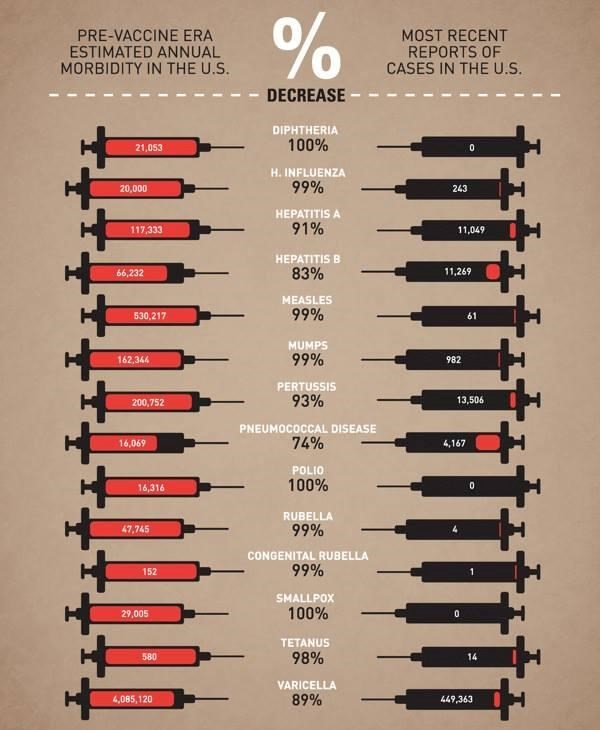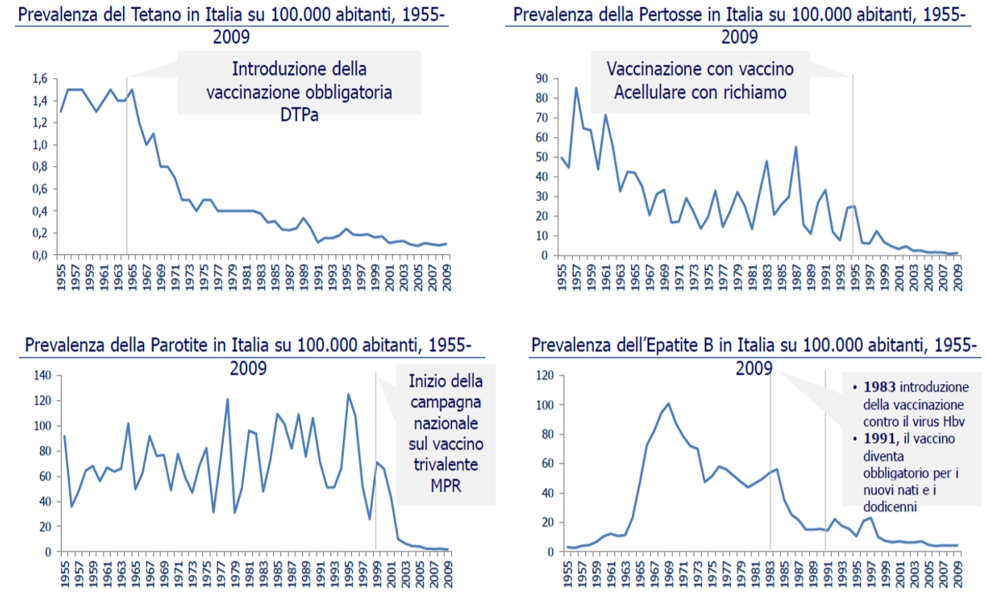It is said that unnecessary vaccines are forced on us, just to boost sales. Can we debunk this myth?
Speech by SItI President at the Conference ‘La Sanità in Italia: falsi miti e vere eccellenze’, held in Rome on 22 April 2015.
The scientific evidence shows that vaccines are, to date, the most effective of all medical interventions ever made by Man1, second only to the purification of water in terms of reducing human mortality2 and still capable of preventing over 2, 5 million deaths every year3. These data should be sufficient to dispel the false myth that vaccination offers are dictated by commercial reasons rather than health and social needs. However, this is a complex topic and needs to be further explored from a scientific viewpoint.
Analysis of the data from the CDC45 (Figure 1) indicates that for 14 vaccine-preventable infectious diseases there were significant reductions in the number of cases a few years after the introduction of vaccination campaigns; for 11 of these the decrease was of over 90% and for two it was 100%. The Italian data for four diseases also confirm this trend6: we have witnessed a complete nosedive in diseases which can be fatal or capable of generating chronic diseases and serious complications including tumours (hepatitis B), permanent paralysis (poliomyelitis and tetanus), congenital malformations (rubella). This is illustrated by the situation of hepatitis B – with the approval of WHO, the vaccine has been universally offered in Italy since 1991 - preventing thousands of cases of tumours of the liver and chronic hepatitis, diseases that, today, are treatable with very expensive therapies. No intellectually honest person could deny this scientific proof that counts vaccines as one of the jewels in the crown of the history of medicine.
On the economic front, the OSMED7 reports indicate that in Italy the total pharmaceutical expenditure on vaccines is around 310 million euro a year, that is just 1.2% of total pharmaceutical expenditure and 2.5% of SSN expenditure. The per capita expenditure for all vaccines in 2011 was €5.05 per year. As a term of comparison, the per capita expenditure for a single statin (atrovastatin) was equal to €7.90 and that for proton pump inhibitors equal to €14.8. We are dealing with organic products with high investment costs, rigorous controls and expensive experiments that do not always lead to the registration of the product.
Cost-effectiveness studies on vaccinations, while not always easy to perform, show unidirectional results. One example is anti-influenza vaccination, for which it was calculated that in Italy, vaccinating the entire population between 50 and 64 years, the maximum investment would be 76 million euro with a saving for the SSN of 746 million euro during the flu season for diagnosis, treatment and hospitalisation i.e. a cost/benefit ratio of 1 to 107.
Nevertheless, the abundance of false myths (alleged side effects8 ; the belief that vaccination indications are prompted by the commercial interests of their producers), some even accepted in judicial sentences, has meant that vaccines have not had an easy ride recently. The oft-repeated motto that vaccines are victims of their own success holds a lot of truth: where vaccinations are used well and the diseases disappear, and the population loses perception of the real risks. It must therefore be up to the international, national and local health authorities to set times and methods for vaccination practices based on clinical, epidemiological and cost-effectiveness evidence which the individual citizen (and even the individual operator) is unable to perceive.
Conclusions
A vaccine is a drug authorised for marketing only following a series of clinical trials to assess its efficacy and safety.
Inclusion in vaccination schedules is suggested by experts in epidemiology, infectious diseases and public health only on the basis of solid scientific evidence.
The myth about vaccines being introduced in order to boost sales is undoubtedly false but, especially nowadays, we must be aware of the need for a renewed commitment from operators, decision makers, researchers and scientific communities in terms of correct information and communication to the citizens with a total absence of conflicts of interest9. By proposing an ethical Regulation our Scientific Society is at the forefront, proposing vaccination opportunities (as happened recently with the calendar for life10) and at the same time dispelling any doubt as to whether it acts in the sole interest of the health of citizens and the socio-economic progress of the nation. This is the mission of public health, this is the mission of our scientific society.
Carlo Signorelli

Figure 1 5

Figure 2 6
Sources / Bibliography
- Ward BJ. Vaccine adverse events in the new millennium: is there reason for concern? Bull World Health Organ. 2000;78(2):205-15.
- Plotkin SL, Plotkin SA. "A short history of vaccination," In: Plotkin S, Orenstein W, Offit PA. Vaccines, 5th edition, Philadelphia: Saunders, 2008.
- World health statistics report 2008. Geneva, World Health Organization, 2008. ISBN: 978 92 4 0682740
- Centers for Disease Control and Prevention. Epidemiology and Prevention of Vaccine-Preventable Diseases. Atkinson W, Wolfe S, Hamborsky J, eds. 12th ed., second printing. Washington DC: Public Health Foundation, 2012. http://www.cdc.gov/vaccines/pubs/pinkbook/download... [accesso 22.04.2015]
- Matthew Herper. How Vaccines Have Changed Our World In One Graphic. Forbes 2013 http://www.forbes.com/sites/matthewherper/2013/02/... [accesso 22.04.2015]
- The European House-Ambrosetti. Meridiano Sanità. Le Coordinate della Salute. Rapporto 2014. http://www.ambrosetti.eu/it/risorse/file/RapportoF... [accesso 22.04.2015]
- Bonanni P, Boccalini S, Battista T, Conversano M. Vaccini, Politiche e Strategie vaccinali. Due casi modello: HPV e influenza stagionale. In Rapporto Prevenzione2013. Fondazione Smith Kline, 2013
- Signorelli C, Odone A, Conversano M, Bonanni P. Deaths after Fluad flu vaccine and the epidemic of panic in Italy. BMJ. 2015 Jan 14; 350:h116.
- Odone A, Fara GM, Giammaco G, F FB, C CS. The future of immunization policies in Italy and in the European Union: The declaration of Erice. Hum Vaccin Immunother. 2015 Mar 25:0. [Epub ahead of print]
- Bonanni P, Azari C, Castiglia P, Chiamenti G, Conforti G, Conversano M, Corsello G, Ferrera G, Ferro A, Icardi G, Macrì PG, Maio T, Ricciardi W, Russo R, Scotti S, Signorelli C, Sudano L, Ugazio AG, Villani A, Vitali Rosati G. [The 2014 lifetime immunization schedule approved by the italian scientific societies]. Epidemiol Prev. 2014 Nov-Dec;38(6 Suppl 2):131-146.



